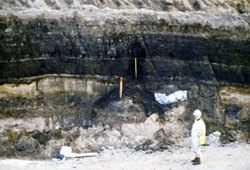
The authors propose that this reflects an increase in methane production, possibly driven by a warmer, wetter climate. They suggest that release of methane from the terrestrial biosphere increased – acting as a positive feedback mechanism to global warming. Says Pancost: “Although we must be careful not to over interpret data from a single site, this does provide insight into how some ecosystems could respond to rapid, warming-induced changes in climate.” However, as Professor Andrew Scott (Royal Holloway) cautions: “We can not use this section as an exact model for interpreting future global warming as the initial climate was very much warmer than that of today.”
“There were other important changes in the terrestrial system seen in the Cobham sequence”, explains Scott. In a paper published earlier in the year the same researchers showed (from qualitative and quantitative coal petrological analyses undertaken on the laminated lignite at the base of the Cobham Lignite Bed) the presence of abundant charcoal derived from wildfires. They considered that charcoal-rich and charcoal-poor layers were indicative of episodic fires and post-fire erosion. Charcoal clasts were derived from living or recently dead plants, and were dominated by the leaf stalks of herbaceous ferns and wood fragments from flowering plants. This charcoal assemblage reflected a low-diversity flora, possibly one adapted to disturbance by fire, derived from a source vegetation subjected to seasonal surface wildfires. The environmental conditions leading up to and across the onset of the PETM were interpreted as incorporating a persistent fire regime with episodic wildfires followed by rainfall and runoff events. They further showed that the fire regime suddenly stops, probably as a result of increased rainfall.
“We have been surprised at the amount of information that we could obtain from such a short section of the rail cutting and were fortunate that the rocks were of an age to help us unravel some of the secrets of this period of rapid global warming”, Professor Scott added. Unfortunately this section is now entombed in concrete!
The Cobham Lignite Bed, from Scalers Hill, Kent, England was the subject of a study, supported by the Leverhulme Trust, by researchers at Royal Holloway University of London (Geology), the Natural History Museum (Palaeontology) and the University of Bristol (Chemistry) led by Professor Margaret Collinson of the Geology Department at Royal Holloway, with Dr David Steart as Post Doctoral assistant.